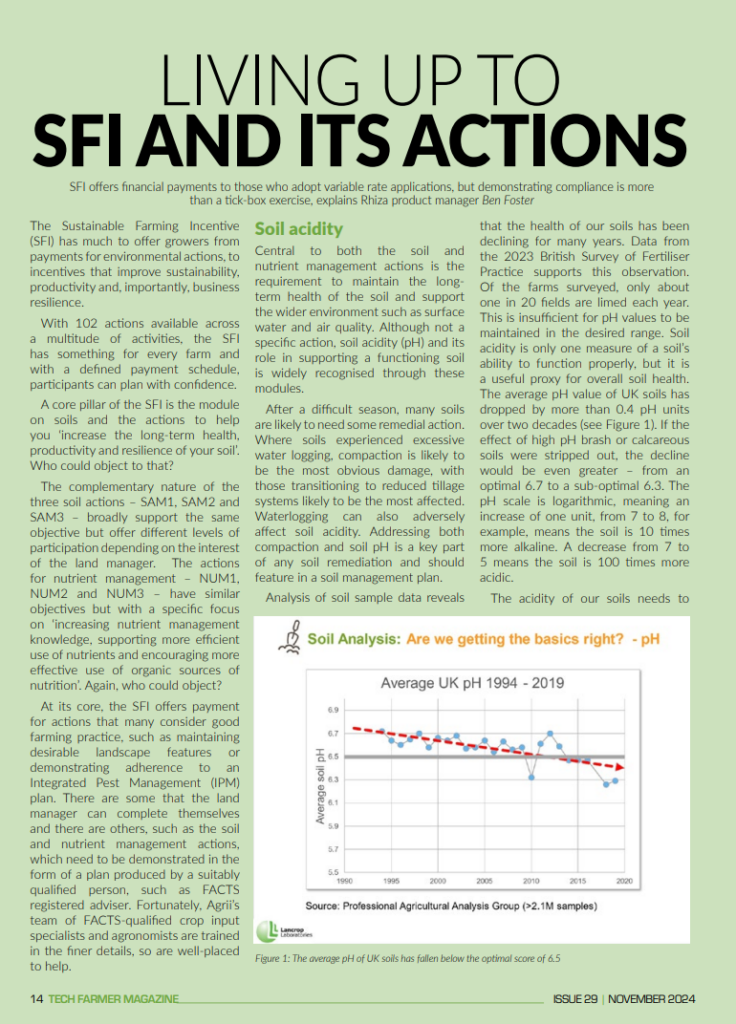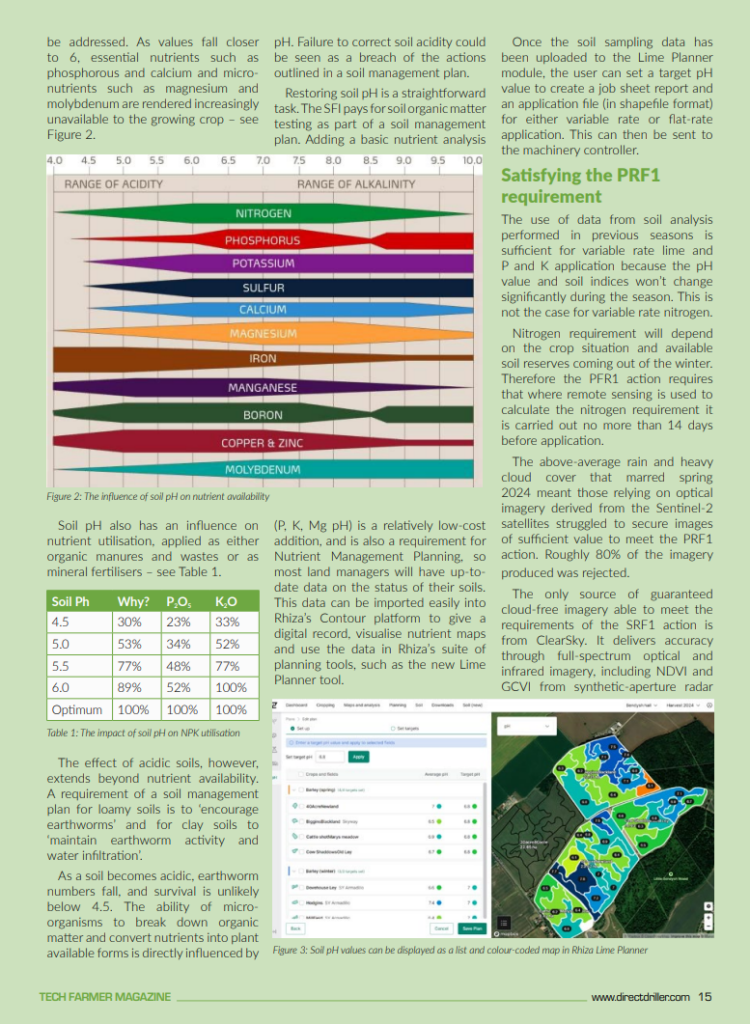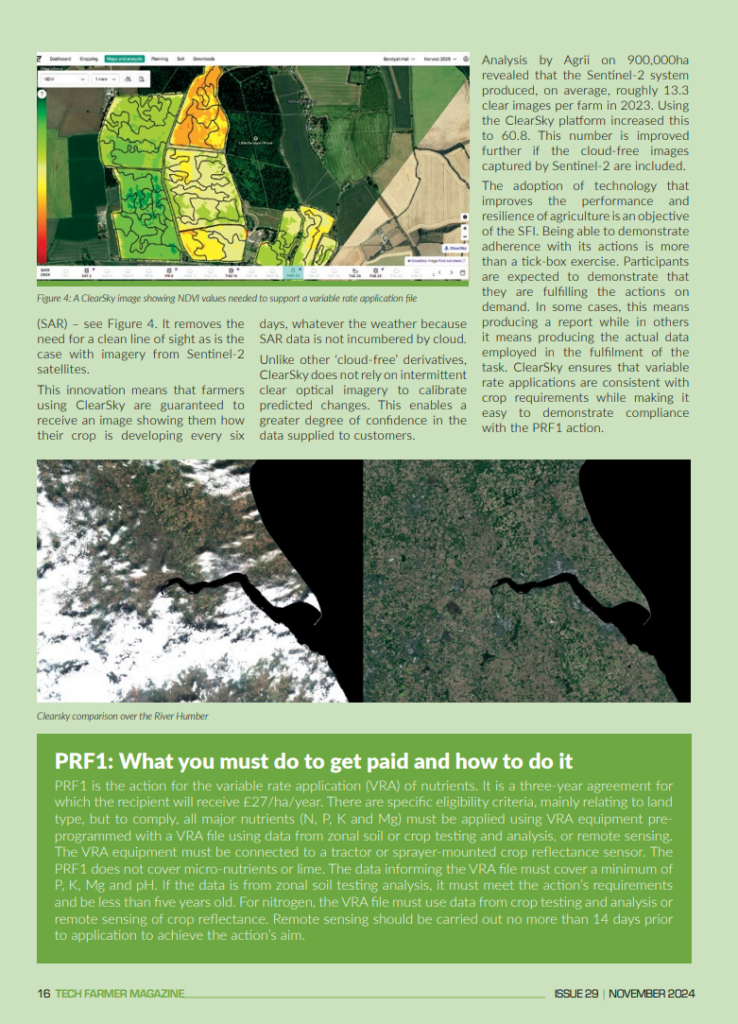The SFI offers financial payments to those who adopt variable rate applications, but demonstrating compliance is more than a tick-box exercise, explains Rhiza product manager Ben Foster
The Sustainable Farming Incentive (SFI) has much to offer growers from payments for environmental actions, to incentives that improve sustainability, productivity and, importantly, business resilience.
With 102 actions available across a multitude of activities, the SFI has something for every farm and with a defined payment schedule, participants can plan with confidence.
A core pillar of the SFI is the module on soils and the actions to help you ‘increase the long-term health, productivity and resilience of your soil’. Who could object to that?
The complementary nature of the three soil actions – SAM1, SAM2 and SAM3 – broadly support the same objective but offer different levels of participation depending on the interest of the land manager. The actions for nutrient management – NUM1, NUM2 and NUM3 – have similar objectives but with a specific focus on ‘increasing nutrient management knowledge, supporting more efficient use of nutrients and encouraging more effective use of organic sources of nutrition’. Again, who could object?
At its core, the SFI offers payment for actions that many consider good farming practice, such as maintaining desirable landscape features or demonstrating adherence to an Integrated Pest Management (IPM) plan. There are some that the land manager can complete themselves and there are others, such as the soil and nutrient management actions, which need to be demonstrated in the form of a plan produced by a suitably qualified person, such as FACTS registered adviser. Fortunately, Agrii’s team of FACTS-qualified crop input specialists and agronomists are trained in the finer details, so are well-placed to help.
Soil acidity
Central to both the soil and nutrient management actions is the requirement to maintain the long-term health of the soil and support the wider environment such as surface water and air quality. Although not a specific action, soil acidity (pH) and its role in supporting a functioning soil is widely recognised through these modules.
After a difficult season, many soils are likely to need some remedial action. Where soils experienced excessive water logging, compaction is likely to be the most obvious damage, with those transitioning to reduced tillage systems likely to be the most affected. Waterlogging can also adversely affect soil acidity. Addressing both compaction and soil pH is a key part of any soil remediation and should feature in a soil management plan.
Analysis of soil sample data reveals that the health of our soils has been declining for many years. Data from the 2023 British Survey of Fertiliser Practice supports this observation. Of the farms surveyed, only about one in 20 fields are limed each year. This is insufficient for pH values to be maintained in the desired range. Soil acidity is only one measure of a soil’s ability to function properly, but it is a useful proxy for overall soil health. The average pH value of UK soils has dropped by more than 0.4 pH units over two decades (see Figure 1). If the effect of high pH brash or calcareous soils were stripped out, the decline would be even greater – from an optimal 6.7 to a sub-optimal 6.3. The pH scale is logarithmic, meaning an increase of one unit, from 7 to 8, for example, means the soil is 10 times more alkaline. A decrease from 7 to 5 means the soil is 100 times more acidic.

Figure 1: The average pH of UK soils has fallen below the optimal score of 6.5
The acidity of our soils needs to be addressed. As values fall closer to 6, essential nutrients such as phosphorous and calcium and micro-nutrients such as magnesium and molybdenum are rendered increasingly unavailable to the growing crop – see Figure 2.

Figure 2: The influence of soil pH on nutrient availability
Soil pH also has an influence on nutrient utilisation, applied as either organic manures and wastes or as mineral fertilisers – see Table 1.
Table 1: The impact of soil pH on NPK utilisation
| Soil pH | N | P2O5 | K2O |
| 4.5 | 30% | 23% | 33% |
| 5.0 | 53% | 34% | 52% |
| 5.5 | 77% | 48% | 77% |
| 6.0 | 89% | 52% | 100% |
| Optimum | 100% | 100% | 100% |
The effect of acidic soils, however, extends beyond nutrient availability. A requirement of a soil management plan for loamy soils is to ‘encourage earthworms’ and for clay soils to ‘maintain earthworm activity and water infiltration’.
As a soil becomes acidic, earthworm numbers fall, and survival is unlikely below 4.5. The ability of micro-organisms to break down organic matter and convert nutrients into plant available forms is directly influenced by pH. Failure to correct soil acidity could be seen as a breach of the actions outlined in a soil management plan.
The Rhiza Lime Planner
Restoring soil pH is a straightforward task. The SFI pays for soil organic matter testing as part of a soil management plan. Adding a basic nutrient analysis (P, K, Mg pH) is a relatively low-cost addition, and is also a requirement for Nutrient Management Planning, so most land managers will have up-to-date data on the status of their soils. This data can be imported easily into Rhiza’s Contour platform to give a digital record, visualise nutrient maps and use the data in Rhiza’s suite of planning tools, such as the new Lime Planner tool.

Figure 3: Soil pH values can be displayed as a list and colour-coded map in Rhiza Lime Planner
Once the soil sampling data has been uploaded to the Lime Planner module, the user can set a target pH value to create a job sheet report and an application file (in shapefile format) for either variable rate or flat-rate application. This can then be sent to the machinery controller.
Satisfying the PRF1 requirement
The use of data from soil analysis performed in previous seasons is sufficient for variable rate lime and P and K application because the pH value and soil indices won’t change significantly during the season. This is not the case for variable rate nitrogen.
Nitrogen requirement will depend on the crop situation and available soil reserves coming out of the winter. Therefore the PFR1 action requires that where remote sensing is used to calculate the nitrogen requirement it is carried out no more than 14 days before application.
The above-average rain and heavy cloud cover that marred spring 2024 meant those relying on optical imagery derived from the Sentinel-2 satellites struggled to secure images of sufficient value to meet the PRF1 action. Roughly 80% of the imagery produced was rejected.
ClearSky
The only source of guaranteed cloud-free imagery able to meet the requirements of the SRF1 action is from ClearSky. It delivers accuracy through full-spectrum optical and infrared imagery, including NDVI and GCVI from synthetic-aperture radar (SAR) – see Figure 4. It removes the need for a clean line of sight as is the case with imagery from Sentinel-2 satellites.

Figure 4: A ClearSky image showing NDVI values needed to support a variable rate application file
This innovation means that farmers using ClearSky are guaranteed to receive an image showing them how their crop is developing every six days, whatever the weather because SAR data is not incumbered by cloud.
Unlike other ‘cloud-free’ derivatives, ClearSky does not rely on intermittent clear optical imagery to calibrate predicted changes. This enables a greater degree of confidence in the data supplied to customers.
Analysis by Agrii on 900,000ha revealed that the Sentinel-2 system produced, on average, roughly 13.3 clear images per farm in 2023. Using the ClearSky platform increased this to 60.8. This number is improved further if the cloud-free images captured by Sentinel-2 are included.

The adoption of technology that improves the performance and resilience of agriculture is an objective of the SFI. Being able to demonstrate adherence with its actions is more than a tick-box exercise. Participants are expected to demonstrate that they are fulfilling the actions on demand. In some cases, this means producing a report while in others it means producing the actual data employed in the fulfilment of the task. ClearSky ensures that variable rate applications are consistent with crop requirements while making it easy to demonstrate compliance with the PRF1 action.
PRF1: What you must do to get paid and how to do it
PRF1 is the action for the variable rate application (VRA) of nutrients. It is a three-year agreement for which the recipient will receive £27/ha/year. There are specific eligibility criteria, mainly relating to land type, but to comply, all major nutrients (N, P, K and Mg) must be applied using VRA equipment pre-programmed with a VRA file using data from zonal soil or crop testing and analysis, or remote sensing. The VRA equipment must be connected to a tractor or sprayer-mounted crop reflectance sensor. The PRF1 does not cover micro-nutrients or lime. The data informing the VRA file must cover a minimum of P, K, Mg and pH. If the data is from zonal soil testing analysis, it must meet the action’s requirements and be less than five years old. For nitrogen, the VRA file must use data from crop testing and analysis or remote sensing of crop reflectance. Remote sensing should be carried out no more than 14 days prior to application to achieve the action’s aim.


